-

新人教版高中英语必修3Unit 3 Diverse Cultures教学设计一
Activity 81.Grasp the main idea of the listening.Listen to the tape and answer the following questions:Who are the two speakers in the listening? What is their relationship?What is the main idea of the first part of the listening? How about the second part?2.Complete the passage.Ask the students to quickly review the summaries of the two listening materials in activity 2. Then play the recording for the second time.Ask them to complete the passage and fill in the blanks.3.Play the recording again and ask the students to use the structure diagram to comb the information structure in the listening.(While listening, take notes. Capture key information quickly and accurately.)Step 8 Talking Activity 91.Focus on the listening text.Listen to the students and listen to the tape. Let them understand the attitudes of Wu Yue and Justin in the conversation.How does Wu Yue feel about Chinese minority cultures?What does Justin think of the Miao and Dong cultures?How do you know that?2.learn functional items that express concerns.Ask students to focus on the expressions listed in activity. 3.And try to analyze the meaning they convey, including praise (Super!).Agree (Exactly!)"(You're kidding.!)Tell me more about it. Tell me more about it.For example, "Yeah Sure." "Definitely!" "Certainly!" "No kidding!" "No wonder!" and so on.4.Ask the students to have conversations in small groups, acting as Jsim and his friends.Justin shares his travels in Guizhou with friends and his thoughts;Justin's friends should give appropriate feedback, express their interest in relevant information, and ask for information when necessary.In order to enrich the dialogue, teachers can expand and supplement the introduction of Miao, dong, Lusheng and Dong Dage.After the group practice, the teacher can choose several groups of students to show, and let the rest of the students listen carefully, after listening to the best performance of the group, and give at least two reasons.

新人教版高中英语选修2Unit 4 Reading and thinking教学设计
【词汇精讲】highlight n.最好或最精彩的部分 vt.突出;强调;使醒目One of the highlights of the trip was seeing the Taj Mahal.这次旅行的亮点之一是参观泰姬陵。Your resume should highlight your skills and achievements.你的简历应该突出你的技能和成就。The report highlights the major problems facing society today.报告强调了当今社会所面临的主要问题。I’ve highlighted the important passages in yellow.我用黄色标出了重要段落。7.Edmonton is freezing cold in winter,with daily temperatures averaging -10 ℃.埃德蒙顿冬季寒冷,日平均气温为-10°C。【词汇精讲】freezing adj.极冷的;冰冻的Leave a basin of water outside in freezing weather.在冰冻的天气里,放一盆水在室外。It’s freezing cold outside so wear a warm coat.外面超冷的,所以穿一个暖和一点的外套吧。8.It was not until 9:30 a.m.that they finally reached the capital of Ontario,Toronto.直到上午9时30分,他们才终于到达多伦多的首府安大略省。【句式剖析】本句是一个强调句,强调的是句子的时间状语until 9:30。含有not...until...的句子的强调句为It is not until...that...,that后面的句子要用肯定形式。It was not until then that I suddenly realized nobody was happier than I was.直到那时我才突然意识到没有人比我更幸福了。

新人教版高中英语选修2Unit 2 Reading and thinking教学设计
Her tutor told her to acknowledge __________ other people had said if she cited their ideas, and advised her _______(read) lots of information in order to form __________wise opinion of her own.Now halfway __________ her exchange year, Xie Lei felt much more at home in the UK. She said __________ (engage) in British culture had helped and that she had been__________ (involve) in social activities. She also said while learning about business, she was acting as a cultural messenger __________(build) a bridge between the two countries. keys:Xie Lei, a 19yearold Chinese student, said goodbye to her family and friends in China and boarded (board) a plane for London six months ago in order to get a business qualification. She was ambitious(ambition) to set up a business after graduation. It was the first time that she had left (leave) home.At first, Xie Lei had to adapt to life in a different country. She chose to live with a host family, who can help with her adaptation (adapt) to the new culture. When she missed home, she felt comforted (comfort) to have a second family. Also Xie Lei had to satisfy academic requirements. Her tutor told her to acknowledge what other people had said if she cited their ideas, and advised her to read lots of information in order to form a wise opinion of her own.Now halfway through her exchange year, Xie Lei felt much more at home in the UK. She said engaging (engage) in British culture had helped and that she had been involved (involve) in social activities. She also said while learning about business, she was acting as a cultural messenger building a bridge between the two countries.

新人教版高中英语选修2Unit 2 Using langauge-Listening教学设计
? B: Absolutely! Getting involved with Chinese cultural activities there definitely helped a lot. I got to practice my Chinese on a daily basis, and I could learn how native Chinese speakers spoke.? A: What do you feel is your biggest achievement?? B: Learning Chinese characters! I have learnt about 1,500 so far. When I first started, I didn't think it was even going to be possible to learn so many, but now I find that I can read signs, menus, and even some easy newspaper articles.? A: What are you most keen on?? B: I've really become keen on learning more about the Chinese culture, in particular Chinese calligraphy. As I have learnt Chinese characters, I have developed a great appreciation for their meaning. I want to explore Chinese characters by learning how to write them in a more beautiful way. ? A: Finally, what do you want to say to anyone interested in learning Chinese?? I have really become keen on learning more about the Chinese culture, in particular Chinese Calligraphy. As I have learnt Chinese character, I have developed a great appreciation for their meaning. I want to explore Chinese characters by learning how to write them in a more beautiful way.? A: Finally, what do you want to say to anyone interested in learning Chinese?? B: I'd say, give it a shot! While some aspects may be difficult, it is quite rewarding and you will be happy that you tried.? A: Thanks for your time. ? B:You're welcome.

新人教版高中英语选修2Unit 3 Using langauge-Listening教学设计
1. How is Hunan cuisine somewhat different from Sichuan cuisine?The heat in Sichuan cuisine comes from chilies and Sichuan peppercorns. Human cuisine is often hotter and the heat comes from just chilies.2.What are the reasons why Hunan people like spicy food?Because they are a bold people. But many Chinese people think that hot food helps them overcome the effects of rainy or wet weather.3.Why do so many people love steamed fish head covered with chilies?People love it because the meat is quite tender and there are very few small bones.4.Why does Tingting recommend bridge tofu instead of dry pot duck with golden buns?Because bridge tofu has a lighter taste.5 .Why is red braised pork the most famous dish?Because Chairman Mao was from Hunan, and this was his favorite food.Step 5: Instruct students to make a short presentation to the class about your choice. Use the example and useful phrases below to help them.? In groups of three, discuss what types of restaurant you would like to take a foreign visitor to, and why. Then take turns role-playing taking your foreign guest to the restaurant you have chosen. One of you should act as the foreign guest, one as the Chinese host, and one as the waiter or waitress. You may start like this:? EXAMPLE? A: I really love spicy food, so what dish would you recommend?? B: I suggest Mapo tofu.? A: Really ? what's that?

新人教版高中英语选修2Unit 4 Learning about Language教学设计
This section guides students to pay attention to the typical context of vocabulary use, helps students accumulate vocabulary around the key vocabulary of this unit, and uses the learned words and word chunks in different contexts to deeply understand their meaning and usage, so as to achieve the purpose of review and consolidation.The teaching design activities aim to guide students to pay attention to the typical context in which the target vocabulary is used, as well as the common vocabulary used in collocation, so that students can complete the sentence with correct words. In terms of vocabulary learning strategies, this unit focuses on cultivating students' ability to pay attention to collocation of words and to use word blocks to express meaning.For vocabulary learning, it is not enough just to know the meaning of a single word, but the most important thing is to master the common collocations of words, namely word blocks.Teachers should timely guide students to summarize common vocabulary collocation, such as verb and noun collocation, verb and preposition collocation, preposition and noun collocation, and so on.1. Guide students to understand and consolidate the meaning and usage of the vocabulary in the context, 2. Guide the students to use the unit topic vocabulary in a richer context3. Let the students sort out and accumulate the accumulated vocabulary, establishes the semantic connection between the vocabulary,4. Enable students to understand and master the vocabulary more effectivelyGuiding the Ss to use unit topic words and the sentence patterns in a richer context.

新人教版高中英语选修2Unit 5 Using langauge-Listening教学设计
The theme of this section is to learn how to make emergency calls. Students should learn how to make emergency calls not only in China, but also in foreign countries in English, so that they can be prepared for future situations outside the home.The emergency telephone number is a vital hotline, which should be the most clear, rapid and effective communication with the acute operator.This section helps students to understand the emergency calls in some countries and the precautions for making emergency calls. Through the study of this section, students can accumulate common expressions and sentence patterns in this context. 1.Help students accumulate emergency telephone numbers in different countries and learn more about first aid2.Guide the students to understand the contents and instructions of the telephone, grasp the characteristics of the emergency telephone and the requirements of the emergency telephone.3.Guide students to understand the first aid instructions of the operators.4.Enable Ss to make simulated emergency calls with their partners in the language they have learned1. Instruct students to grasp the key information and important details of the dialogue.2. Instruct students to conduct a similar talk on the relevant topic.Step1:Look and discuss:Match the pictures below to the medical emergencies, and then discuss the questions in groups.
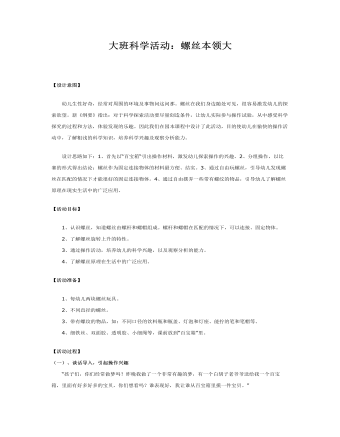
大班科学教案:螺丝本领大
设计思路如下:1、首先以“百宝箱“引出操作材料,激发幼儿探索操作的兴趣。2、分组操作,以比赛的形式得出结论:螺丝作为固定连接物体的材料最方便、结实。3、通过自由玩螺丝,引导幼儿发现螺丝在匹配的情况下才能很好的固定连接物体。4、通过自由摆弄一些带有螺纹的物品,引导幼儿了解螺丝原理在现实生活中的广泛应用。【活动目标】1、认识螺丝,知道螺丝由螺杆和螺帽组成。螺杆和螺帽在匹配的情况下,可以连接、固定物体。2、了解螺丝旋转上升的特性。3、通过操作活动,培养幼儿的科学兴趣,以及观察分析的能力。4、了解螺丝原理在生活中的广泛应用。
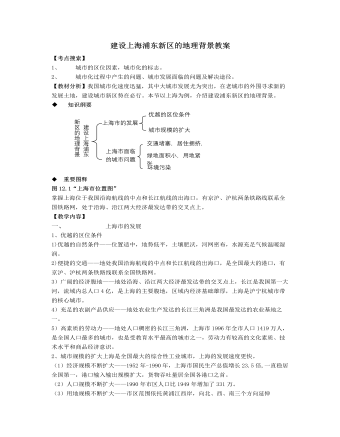
人教版高中地理选修2建设上海浦东新区的地理背景教案
2、上海是全国最大的商业中心,上海港是全国最大的港口。商业中心区位选择因素与港口的区位选择因素的共性条件是( )A、自然地理条件B、经济地理条件C、地理位置D、经济腹地3、中国政府宣布开发上海浦东的时间是( )A、1978年B、1985年C、1989年D、1990年4、有关上海优越区位条件的叙述,错误的是( )A、长江三角洲可提供充足的农副产品B、是全国最大的交通枢纽C、是我国最大城市带的核心城市D、是我国面积最大的直辖市5、目前上海市面临的最主要的人口问题是( )A、人口老龄化,青壮年赡养照顾众多老人负担过重B、卫星城镇人口比重大C、人口基数大,自然增长率高D、人口年龄构成轻,生育高峰压力大6、城市问题产生的主要原因是( )A、城市规模扩大B、城市基础设施相对滞后C、城市管理混乱D、城市人口规模和经济规模的迅速扩大7、下列可反映上海市的城市问题的是( )A、上海市区人均道路面积略高于北京市区B、上海市沙尘暴天气多发C、上海市许多家庭三代人同室居住D、上海市人均绿地面积稍高于重庆
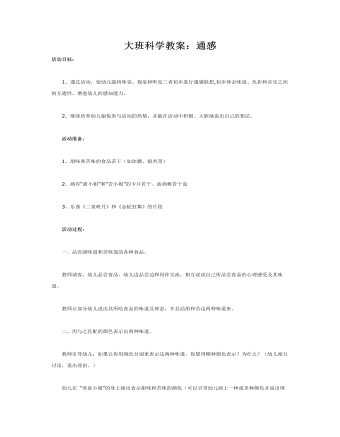
大班科学教案:通感
活动准备: 1、甜味和苦味的食品若干(如冰糖、银杏等) 2、画有“甜小姐”和“苦小姐”的卡片若干、油画棒若干盒 3、乐曲《二泉映月》和《金蛇狂舞》的片段 活动过程: 一、品尝甜味道和苦味道的各种食品。 教师请客,幼儿品尝食品,幼儿边品尝边和同伴交流,相互说说自己所品尝食品的心理感受及其味道。 教师让部分幼儿说出其所吃食品的味道及神态,并总结甜和苦这两种味道来。
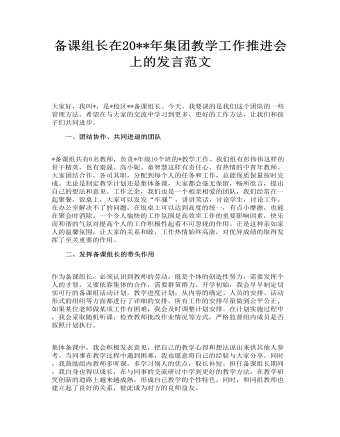
备课组长在集团教学工作推进会上的发言范文
作为备课组长,必须认识到教师的劳动,既是个体的创造性努力,需要发挥个人的才智,又要依靠集体的合作,需要群策群力。开学初始,我会早早制定切实可行的备课组活动计划,教学进度计划,从内容的确定、人员的安排、活动形式的组织等方面都进行了详细的安排。所有工作的安排尽量做到公平公正,如果某位老师做某项工作有困难,我会及时调整计划安排。在计划实施过程中,我会采取随机听课,检查教师批改作业情况等方式,严格监督组内成员是否按照计划执行。
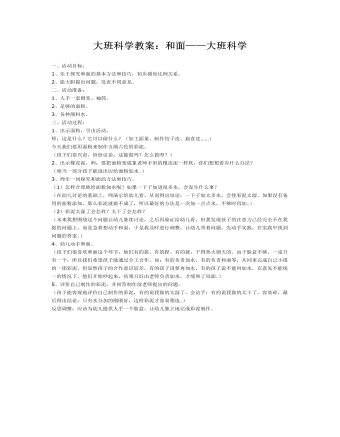
大班科学教案:和面——大班科学
二、活动准备: 1、人手一套围兜、袖筒。 2、足够的面粉。 3、各种颜料水。 三、活动过程: 1、出示面粉,引出活动。 师:这是什么?它可以做什么?(加工面条、制作饺子皮、扁食皮……) 今天我们要用面粉来制作五颜六色的彩泥。 (孩子们很兴奋,纷纷议论:这能做吗?怎么做呀?) 2、出示橡皮泥,师:要把面粉变成象老师手里的橡皮泥一样软,你们想想看有什么办法? (相当一部分孩子能说出应给面粉加水。)
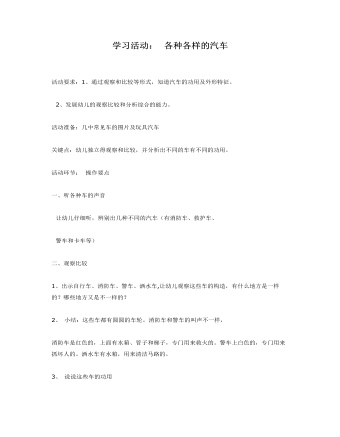
中班科学课件教案:各种各样的汽车
一、听各种车的声音 让幼儿仔细听,辨别出几种不同的汽车(有消防车、救护车、 警车和卡车等)二、观察比较1、出示自行车、消防车、警车、洒水车,让幼儿观察这些车的构造,有什么地方是一样的?哪些地方又是不一样的?2、小结:这些车都有圆圆的车轮。消防车和警车的叫声不一样,消防车是红色的,上面有水箱、管子和梯子,专门用来救火的。警车上白色的,专门用来抓坏人的。洒水车有水箱,用来清洁马路的。
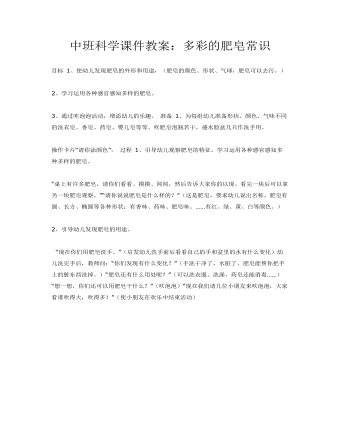
中班科学课件教案:多彩的肥皂常识
2、学习运用各种感官感知多样的肥皂。3、通过吹泡泡活动,增添幼儿的乐趣。准备 1、为每组幼儿准备形状、颜色、气味不同的洗衣皂、香皂、药皂、婴儿皂等等。吹肥皂泡瓶若干,盛水脸盆几只作洗手用。操作卡片“请你涂颜色”。过程 1、引导幼儿观察肥皂的特征,学习运用各种感官感知多种多样的肥皂。
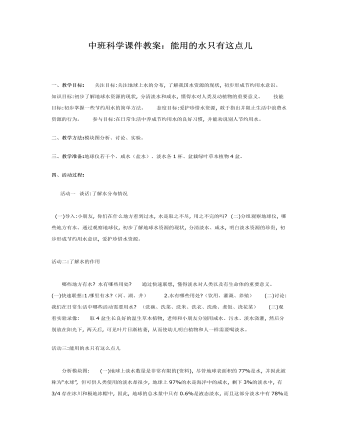
中班科学课件教案:能用的水只有这点儿
二、教学方法:模块图分析、讨论、实验。 三、教学准备:地球仪若干个、咸水(盐水)、淡水各1杯、盆栽绿叶草本植物4盆。 四、活动过程: 活动一 谈话:了解水分布情况 (一)导入:小朋友, 你们在什么地方看到过水, 水是取之不尽, 用之不完的吗? (二)分组观察地球仪, 哪些地方有水。通过观察地球仪, 初步了解地球水资源的现状, 分清淡水、咸水, 明白淡水资源的珍贵, 初步形成节约用水意识, 爱护珍惜水资源。活动二:了解水的作用 哪些地方有水? 水有哪些用处? 通过快速联想, 懂得淡水对人类以及有生命体的重要意义。 (一)快速联想:1.哪里有水?(河、湖、井) 2.水有哪些用处?(饮用、灌溉、养殖)
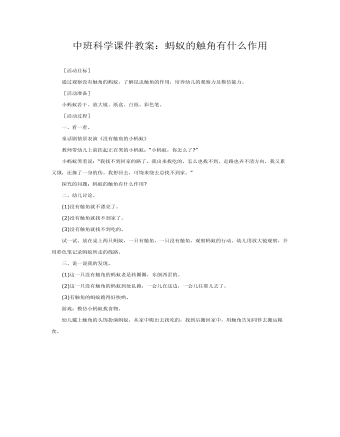
中班科学课件教案:蚂蚁的触角有什么作用
[活动准备] 小蚂蚁若干、放大镜、纸盒、白纸、彩色笔。 [活动过程] 一、看一看。 童话剧情景表演《没有触角的小蚂蚁》 教师带幼儿上前扶起正在哭的小蚂蚁:“小蚂蚁,你怎么了?” 小蚂蚁哭着说:“我找不到回家的路了。我出来找吃的,怎么也找不到,走路也弄不清方向,我又累又饿,还撞了一身的伤。我想回去,可绕来绕去总找不到家。” 探究的问题:蚂蚁的触角有什么作用? 二、幼儿讨论。(1)没有触角就不漂亮了。(2)没有触角就找不到家了。
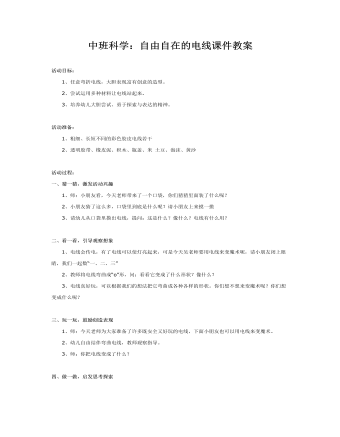
中班科学:自由自在的电线课件教案
2、尝试运用多种材料让电线站起来。3、培养幼儿大胆尝试、勇于探索与表达的精神。 活动准备:1、粗细、长短不同的彩色胶皮电线若干2、透明胶带、橡皮泥、积木、瓶盖、米土豆、泡沫、黄沙 活动过程:一、猜一猜,激发活动兴趣1、师:小朋友看,今天老师带来了一个口袋,你们猜猜里面装了什么呢?2、小朋友猜了这么多,口袋里到底是什么呢?请小朋友上来摸一摸3、请幼儿从口袋里摸出电线,提问:这是什么?像什么?电线有什么用?

中班语言课件教案:故事:鼠宝宝学外语
活动内容:文学活动 仿编诗歌《梳子》活动目标: 1. 初步引导幼儿学习仿编诗歌,培养幼儿仿编诗歌的兴趣。2. 巩固幼儿对诗歌内容的理解,进一步感受作品的表现手法,增进幼儿对学习诗歌的兴趣。3. 使幼儿进一步了解各种事物之间的相互关系。4. 通过活动提高幼儿的观察能力、理解能力、模仿能力、想象能力及创造能力。活动准备:1. 幼儿已经初步学习过诗歌《梳子》;已有一定的各种事物之间的联系的直接或间接经验。2. 多媒体教学设备及电脑课件一套;录音机一台、空白磁带一盒。3. 室外布置成美术图片展览馆,在课前带幼儿进行参观;幼儿操作卡片及背景图。 4. 教师布置成影剧院形式;幼儿每人一张写有数字的图形卡片。
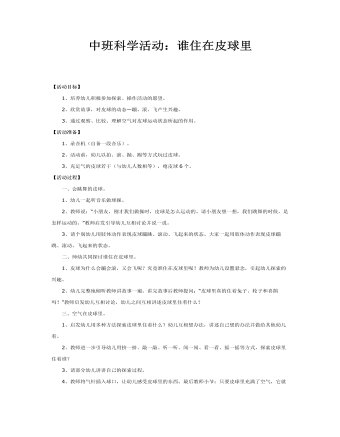
中班科学活动:谁住在皮球里课件教案
2、欣赏故事,对皮球的动态—蹦、滚、飞产生兴趣。3、通过观察、比较、理解空气对皮球运动状态所起的作用。【活动准备】1、录音机(自备一段音乐)。2、活动前,幼儿以拍、滚、抛、踢等方式玩过皮球。3、充足气的皮球若干(与幼儿人数相等),瘪皮球6个。【活动过程】 一、会跳舞的皮球。1、幼儿一起听音乐做球操。2、教师说:“小朋友,刚才我们做操时,皮球是怎么运动的。请小朋友想一想,我们跳舞的时候,是怎样运动的。”教师启发引导幼儿互相讨论并说一说。3、请个别幼儿用肢体动作表现皮球蹦跳、滚动、飞起来的状态。大家一起用肢体动作表现皮球蹦跳、滚动、飞起来的状态。
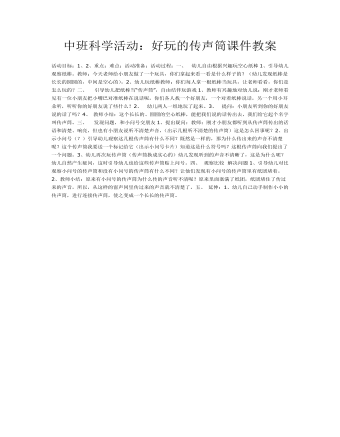
中班科学活动:好玩的传声筒课件教案
2、重点:难点:活动准备:活动过程:一、幼儿自由根据兴趣玩空心纸棒1、引导幼儿观察纸棒。教师:今天老师给小朋友做了一个玩具,你们拿起来看一看是什么样子的?(幼儿发现纸棒是长长的圆圆的,中间是空心的)。2、幼儿玩纸棒教师:你们每人拿一根纸棒当玩具,让老师看看,你们是怎么玩的?二、引导幼儿把纸棒当“传声筒”,自由结伴玩游戏1、教师有兴趣地对幼儿说:刚才老师看见有一位小朋友把小嘴巴对准纸棒在说话呢,你们各人找一个好朋友,一个对着纸棒说话,另一个用小耳朵听,听听你的好朋友说了些什么?2、幼儿两人一组地玩了起来。3、提问:小朋友听到你的好朋友说的话了吗?4、教师小结:这个长长的、圆圆的空心纸棒,能把我们说的话传出去,我们给它起个名字叫传声筒。三、发现问题,和小问号交朋友1、提出疑问:教师:刚才小朋友都听到从传声筒传出的话语和清楚、响亮,但也有小朋友说听不清楚声音,(出示几根听不清楚的传声筒)这是怎么回事呢?

